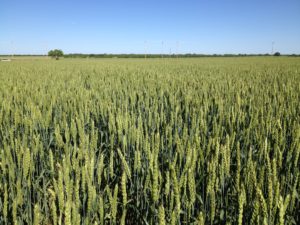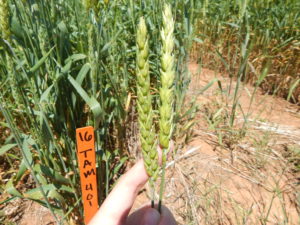by Dr. Calvin Trostle, Professor & Extension Agronomist, TAMU Dept. of Soil & Crop Sciences, Lubbock, 806-746-6101, ctrostle@ag.tamu.edu;
Discussion of forage quality it is fairly common, and the emphasis placed on forage quality among forage growers and livestock feeders ranges from none to strong consideration. Texas A&M AgriLife (Trostle) discusses examples of forage quality as well as tips for producing, selling, buying, and storing different forages in a new PowerPoint that examines these issues from several viewpoints. There are a number of considerations participants in the forage production, marketing, and utilization that individuals can do to enhance the benefit as a grower or user. The update “Annual Grass Forage Quality Considerations” is posted on the Texas A&M AgriLife Research & Extension Center website at Lubbock, see https://lubbock.tamu.edu/programs/crops/other-field-crops/forage/
A specific focus in this forage update involves beardless wheat, which is common in much of Texas (Fig. 1). This includes popular varieties like TAM 401 (Fig. 2), TAM 204, and ‘Razor’ from AgriPro/Syngenta. There are also thousands of Texas acres planted to generic ‘Russian’ beardless wheats including HG-9, Eldorado, etc.
In other outlets I have discussed the grain yield drag that typically occurs with beardless wheats in grain production. For many years the Texas High Plains wheat group has examined the grain yield of beardless wheats vs. conventional bearded wheat. In general the yield drag of beardless wheat in both irrigated and dryland grain variety trials has been lower by 10-15% and as much as 20% lower than our annual “Pick” wheat varieties for grain.
Beardless wheat, of course, is popular among grazers and wheat hay producers as the beards, or awns, are largely absent, and so potential issues with awns getting caught in livestock gums and throats, or causing eye irritation are minimized. Some beardless wheats are “awnletted” which means they may have short awns of about ½”, but these do not generally cause problems with feeding (Fig. 3).

Fig. 1. Tam 204 beardless wheat at a common growth stage (headed to soft dough) often used for hay. (Photo courtesy Dr. Jackie Rudd, Amarillo, TX).

Fig. 2. Beardless TAM 401 wheat with early grain development. Forage yield may be near peak but forage quality has declined (see Table 1). (Photo courtesy Dr. Emi Kimura, Vernon, TX).

Fig. 3. A few short awns (1/2”) are observed on TAM 204 (left) vs. TAM 401. (Photo courtesy Dr. Emi Kimura, Vernon, TX).
But is beardless wheat superior to regular bearded wheat? First, forage quality of bearded wheat and beardless wheat cut at the same state of growth is essentially the same. Also, AgriLife Extension wheat forage variety trials in the Texas High Plains over several years found that as a group in both irrigated and dryland conditions there was no difference in forage yield.
But what is it about beardless wheat that is viewed so highly? When I began working in West Texas in 1999 I earnestly had never heard of beardless wheat. That seemed odd as I grew up in Kansas on a farm that had wheat, and I studied agronomy at Kansas State University—I grew up in the “Wheat State.” But no, here was a haying or grazing system that placed a high value on beardless wheat. (Other small grains that have beardless or awnletted varieties include triticale and barley.)
Forage quality of any type—summer annual grasses like sorghum/sudan, winter small grains, annual legumes, and perennial grasses—declines with maturity. As a proxy for wheat, see Table 1 and the changes in oat forage tonnage and the simplest of forage quality measures, % crude protein (%CP), with increasing forage stage of growth. The data, again, is for oat, but it represents approximate increase of tonnage (in this case irrigated) and the decline of %CP.
Table 1. Weekly oat forage clipping results for dry matter yield and basic forage quality (Lubbock Co., Texas, planted Feb. 15). In oats there is no issue with beards, but the trends of increasing forage dry matter and decreasing forage feed value raise the question of what is the optimum time to mow the oats.
|
Growth Stage |
Harvest
Date |
Dry Hay
Lbs./A |
%Crude
Protein |
Lbs. CP
per acre |
| Early Boot | May 17 | 3,240 | 18.4 | 596 |
| Init. Heading | May 24 | 4,510 | 16.3 | 735 |
| Fully Headed | May 31 | 5,465 | 13.9 | 760 |
| Milk | June 7 | 6,010 | 12.5 | 751 |
| Mealy Ripe | June 14 | 6,420 | 11.5 | 738 |
| Firm Dough | June 21 | 6,845 | 8.7 | 596 |
In many forages boot to late boot or possible initial heading is often viewed as the best compromise between forage tonnage and forage quality. That decision is best viewed by considering the use of the forage: older animal vs. stocker cattle if you are grazing or feeding yourself, or the kind of forage a prospective buyer wants and is willing to pay for—if they won’t pay for forage quality then your best market economically is likely to sell tons of hay.
The Trap of Beardless Wheat—Exposed
Do you see what my concern is? Because beardless wheat is customarily viewed as something that you can let head out to a more advanced stage of maturity, growers and feeders are unwittingly accepting lower forage quality. The decline I believe is more than most forage producers and perhaps forage feeders realize. The only silver lining might be having a buyer that would never pay for higher forage quality, so you can grow higher tonnage of beardless wheat that can still be safely fed. That lower quality forage may require supplementation, which can be costly. Or animals simply are not growing as much.
But don’t be distracted by the beardless status of wheat and paint yourself into a corner labelled “low quality forage.” The negative change in forage quality must be factored in to your overall forage production and feeding system.

Calvin Trostle
Professor and Extension Specialist
Lubbock, TX
803.746.6101
ctrostle@ag.tamu.edu